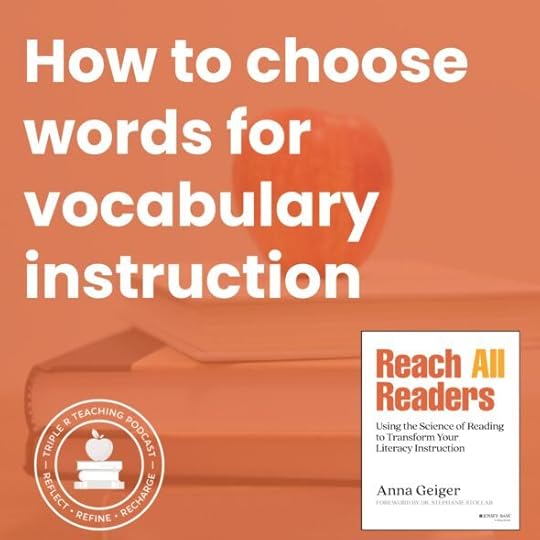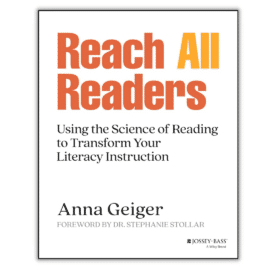How to choose words for vocabulary instruction
 ��TRT Podcast #175: How to choose words for vocabulary instruction
��TRT Podcast #175: How to choose words for vocabulary instructionWe know it’s important to teach particular vocabulary words in depth – but how do we choose from the many thousands of words that students might encounter? These six questions will help you choose words for vocabulary instruction.
Listen to the episode hereFull episode transcriptTranscript
Download
New Tab
Hello! This is Anna Geiger from the Measured Mom, coming to you with a very short, to-the-point podcast episode that's part of a series that serves as a countdown to the release of my new book, "Reach All Readers," coming on July 23rd, 2024.
Before we get into it, here's an endorsement from the wonderful Margaret Goldberg, who is not only a brilliant teacher, but also an amazing writer and presenter, and she's the co-founder of the Right to Read project. She shared, "We've long needed 'Reach All Readers,' a book on effective reading instruction written for teachers by a teacher. Anna presents what she's learned about the science of reading and instruction in an accessible and useful text. You'll want to read it cover to cover, discuss chapters with colleagues, and hang on to it as a reference book." Thank you so much to Margaret Goldberg for that very kind endorsement. I have an incredible amount of respect for her and all the work that she does.
Today we're going to look very briefly at how to choose vocabulary words for instruction.
Vocabulary, of course, is the knowledge of words and their meanings, and meaningful vocabulary instruction involves discussions of words, using words in a variety of contexts, and teaching students to learn words on their own. I get into all of that in chapter seven, but for right now, we're just going to briefly look at how to choose words for in-depth instruction.
You may have heard of Beck and McKeown's three tiers of vocabulary words.
Tier 1 words are words that most kids know when they come to school, unless they're learning English. It's words like "ball, chair, play," and things like that.
The Tier 2 words are the words that are useful for in-depth instruction because they're words that kids are unlikely to learn on their own but are likely to encounter in text that they listen to or read.
Tier 3 words are also good for instruction, but maybe not as in-depth as in Tier 2 because they have limited use. They are for specific content areas. If you're teaching a unit on whales, Tier 3 words might include "baleen" or "plankton." They're good to know, but we tend to spend more time on those Tier 2 words.
So how do you choose Tier 2 words for instruction? There are different ways to do this. I had a podcast episode with Dr. Lorraine Hammond, and she has helped schools develop a whole-school vocabulary routine. They actually have lists of words that they have on a particular theme, and they just change them per grade. During a particular week, everybody's learning words from a particular theme. This is a really neat, effective way to build kids' vocabulary because you're building on what's been taught in previous grades.
If you do not have a whole-school approach to vocabulary instruction, you may want to choose your vocabulary words from the books that you read to your students or that they read. If the books that you're reading aloud do not have strong vocabulary words, you can add vocabulary words. Even if they're not in the text, you can teach a word that has to do with the topic of the text.
Let's say we're looking in the text and we're trying to choose some words to teach in depth. What types of questions should we ask ourselves?
Well, number one, is this a word that many of my students probably don't know? I know this is a really tricky one, and it really changes from class to class, so you really need to think about the groups of students in front of you.
Then you want to ask yourself, is this a word they're unlikely to learn on their own? In other words, it's probably not something they're going to hear in everyday conversation.
Next, is this a word that they're likely to encounter in text, whether I read it to them or they read it themselves? If you find a word that you didn't know the meaning of, it's probably not a word that you need to give explicit instruction on, because if you're an adult and you've never heard the word before, it's probably not one they're going to encounter very often.
Ask yourself, is this a word for which they understand the general concept? For example, the word "euphoric" means really, really excited. They know what really, really excited means. The word "melancholy" means a feeling of sadness. They know what sadness means. Choose words that they can understand as long as you give them a kid-friendly definition.
Is this a word that can be applied in many contexts? If it is, then you've multiplied the usability of this word.
Finally, can you teach other words in the same family? I used to think of word families as just "pat, mat, rat," the rhyming word families, but actually I've learned that there's so much more to that. If you had the word "adhere," for example, which means to stick to something, you could do "adhere, adherence, adhesive, adhered, adhering." So think about if there are other words you can also teach to get more bang for your buck.
Those were some questions to ask when choosing vocabulary words to teach in depth. There's much, much more to the vocabulary chapter, including lots of specific ways that you can help kids remember words for the future. You're invited to pre-order my book, "Reach All Readers," which you can get wherever books are sold. You can buy it on Amazon, Barnes & Noble, Target, Bookshop, BAM!, or ThriftBooks. Thanks so much for considering, and I'll talk to you next time!
That's all for this episode of Triple R Teaching. For more educational resources, visit Anna at her home base, themeasuredmom.com, and join our teaching community. We look forward to helping you reflect, refine, and recharge on the next episode of Triple R Teaching.
Scroll back to top
Sign up to receive email updates
Enter your name and email address below and I'll send you periodic updates about the podcast.
powered by
Pre-order my new book and get a FREE bonus!

You’ll love this reader-friendly guide to the science of reading! Learn how to put the research into action so you can reach ALL readers. Pre-order before July 23 and get my Science of Reading Mini-Course – FREE!
PRE-ORDER NOW
The post How to choose words for vocabulary instruction appeared first on The Measured Mom.
Anna Geiger's Blog
- Anna Geiger's profile
- 1 follower



